Review information
Platform reviewed: Nintendo Switch
Available on: Nintendo Switch
Release date: March 22, 2024
Princess Peach: Showtime! is an action-adventure game that’s overflowing with the boundless creativity and charm characteristic of some of the best recent mainline Super Mario outings like Super Mario Odyssey and Super Mario Bros. Wonder. Despite its more linear design and basic control scheme compared to those games, it’s packed with memorable stages and mechanics that make the most of the charming theatrical theme in truly imaginative ways.
The simplicity means that it’s one of the most approachable first-party games on Nintendo Switch making it a super choice for younger or more casual players, though seasoned gamers will still find plenty to enjoy in its brilliant boss fights and tricky challenge modes. Wrap it all up in an attractive art direction and throw in a raft of collectibles hidden throughout each stage and you’ve got an impressively well-rounded package that ranks among some of the best Nintendo Switch games available to play right now.
Setting the stage
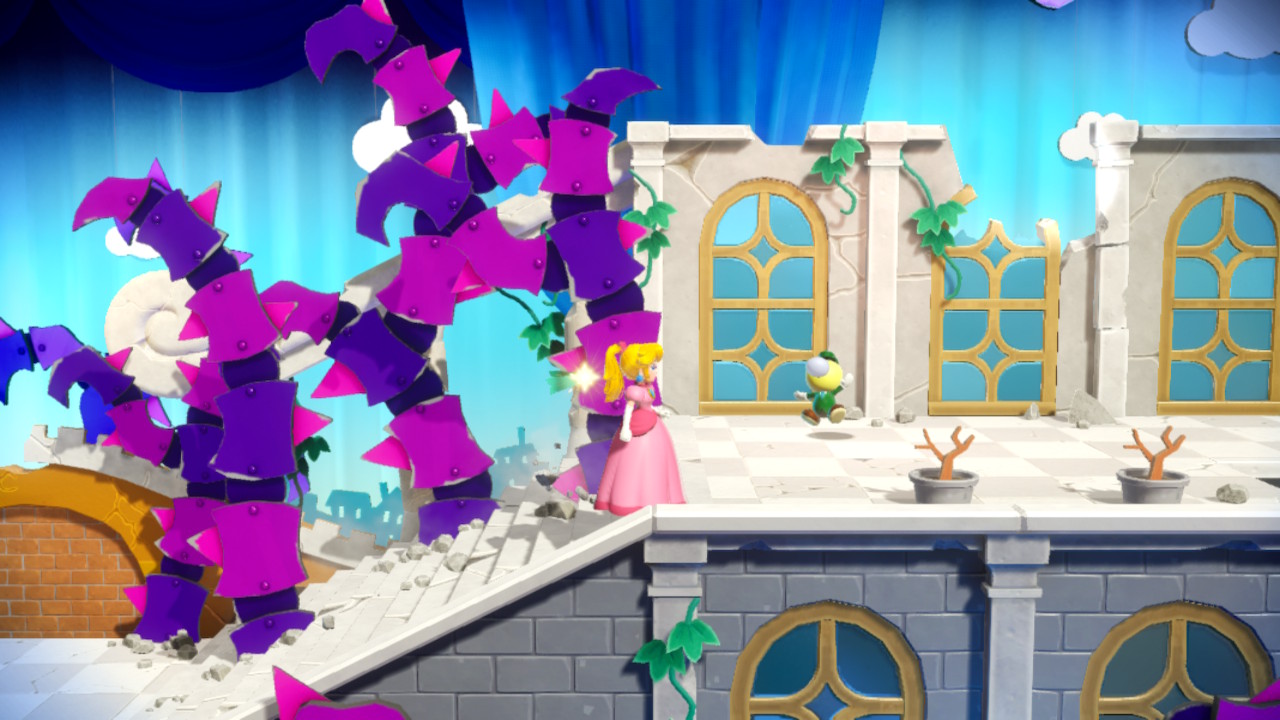
The action kicks off in the sprawling Sparkle Theater, nestled in the little bay far from the Mushroom Kingdom where Princess Peach has been trapped by the malevolent Madame Grape and her legion of purple minions. Grape has corrupted the theater’s plays with her malign influence and caused all of the lead actors to disappear, leaving it up to Peach and the theater’s magical guardian Stella to save the day. It’s a simple setup that is conveyed through an introductory cutscene that is lavishly animated but rather jarringly relies on text dialogue rather than any kind of audio narration.
Still, it’s only a minor omission that is quickly forgotten once you’re thrust into the hub world of the theater’s foyer. It’s divided into five floors, each containing doors leading to different levels, and sits above a mysterious basement. There are thirty main stages in total, arranged into groups of three with each trio representing the entirety of a specific play. They’re spread out evenly across the floors, though each ends with a final stage that is accessed through the basement.
The plays all follow unique themes, ranging from a lighthearted Wild West romp to more unconventional additions like a sci-fi action thriller. They’re all brought to life by the cartoon-like visuals that are filled to the brim with theatrical details and flourishes. The scenery has a distinctly hand-crafted look, with floating clouds that are suspended from visible wires. They cast prominent shadows on the backdrops behind them which, while a simple effect, helps lend everything a wonderful sense of depth.
Despite the side-on perspective, stages are also fully three dimensional and allow for back-and-forth movement in addition to side-scrolling traversal. Bright cones of stage lighting highlight important objectives and follow Peach as you explore – likely to be a huge help for players who are less experienced in traversing 3D environments. This, in addition to an optional item that grants three extra lives and can be obtained from a non-player character (NPC) in the foyer, intelligently incorporates more forgiving elements in a manner that feels both natural and unintrusive.
Dress rehearsal
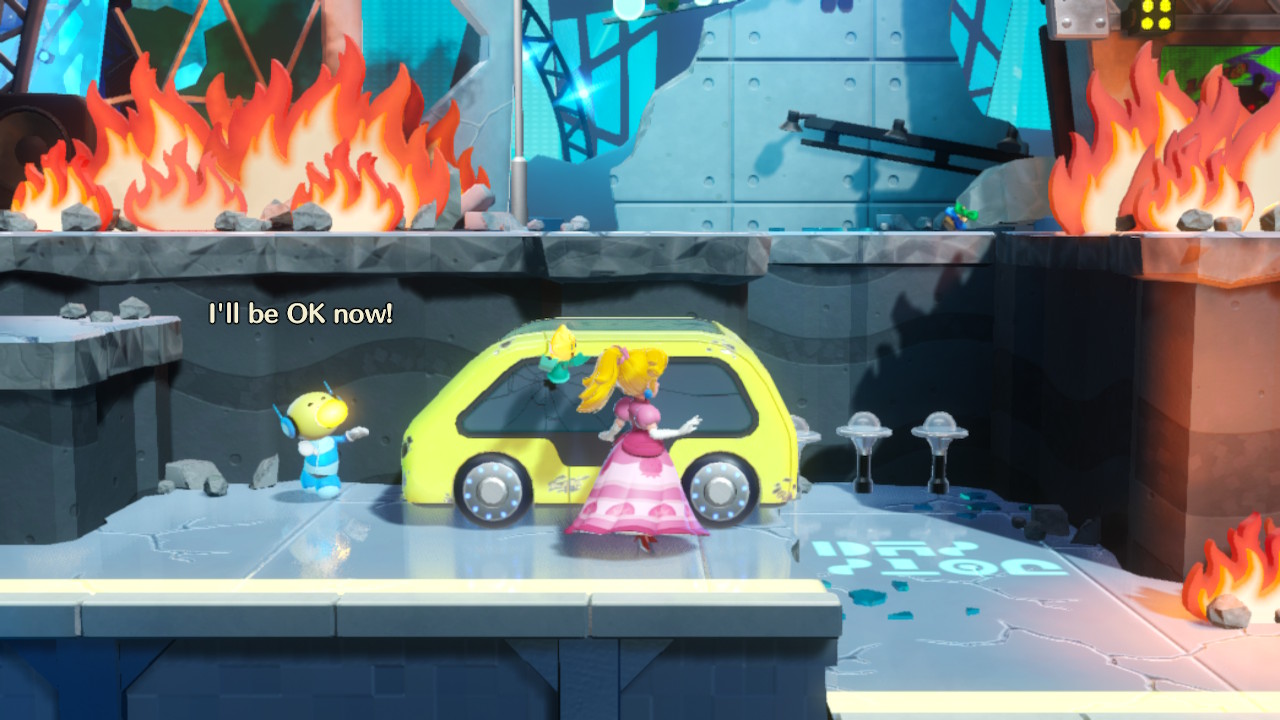
Aside from the rare brief platforming segment, the overall pace of Princess Peach: Showtime! is more pedestrian than more traditional Super Mario adventures. Peach has slow movement speed and all of her actions are controlled entirely with just three buttons. You tap the A button to jump, hit the B button to interact, and occasionally press ZL or ZR in order to travel to secret areas when you’re standing on special spots hidden throughout each level.
In her default getup, Peach is armed with a magical ribbon that can defeat Grape’s minions, trigger key items like lamps or doors to progress, or inspire any dejected supporting actors that you stumble across. Running around mindlessly tapping that button on almost everything that you see isn’t the most engaging or subtle formula and the very early sections of the first few stages suffer as a result.
You’re soon given a transformation, however, which is where Princess Peach: Showtime! is at its absolute best. Modeled after the costumes of the missing lead actors, each play has its own unique transformation that grants Peach a wide range of special abilities. Every new arrival feels remarkably distinct, spicing up the basic formula with elements drawn from entirely different genres. The Ninja Peach transformation, for example, incorporates elements of stealth games, allowing you to hide in tall grass and quietly take down unsuspecting foes with a quick kunai slash.
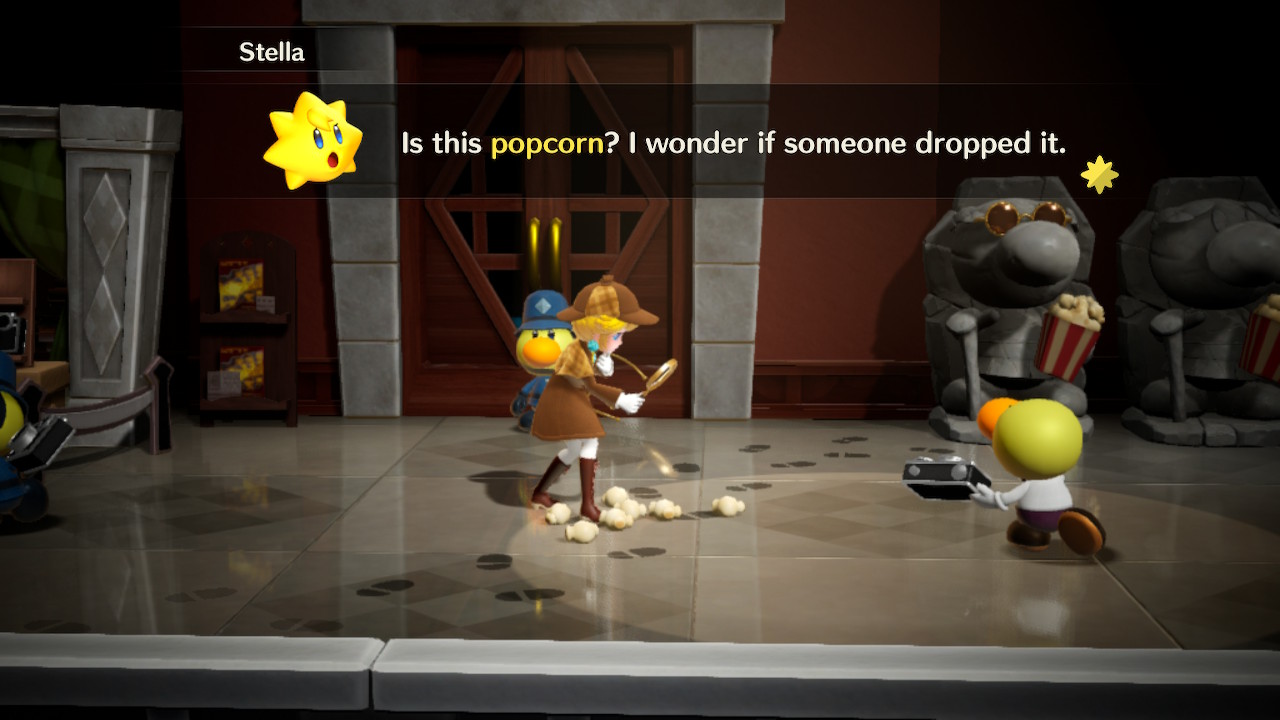
The Detective Peach transformation plays much more like a story-driven adventure, where you solve crimes by chatting to NPCs and using your magnifying glass to track down hidden clues. The Mermaid Peach transformation is something akin to a puzzle game, as you guide schools of fish through maze-like gauntlets under increasingly strict time limits. Although I enjoyed my time with each and every transformation, the button-mashing cookie baking and rapid cake decoration challenges of the Patissiere Peach transformation were a personal highlight that absolutely oozed that Mario Party minigame charm.
Unfortunately, some transformations do push the game’s uneven technical performance to the fore. Loading times are long and a few levels suffer from noticeable framerate dips in busy moments. By far the worst example was one particular Figure Skater Peach stage that involved careful timing to pull off ice skating tricks. The choppy framerate made it frustratingly difficult to get into a definite rhythm and caused me to miss a fair few jumps the first time around which is disappointing, especially in a first-party release.
Best bit
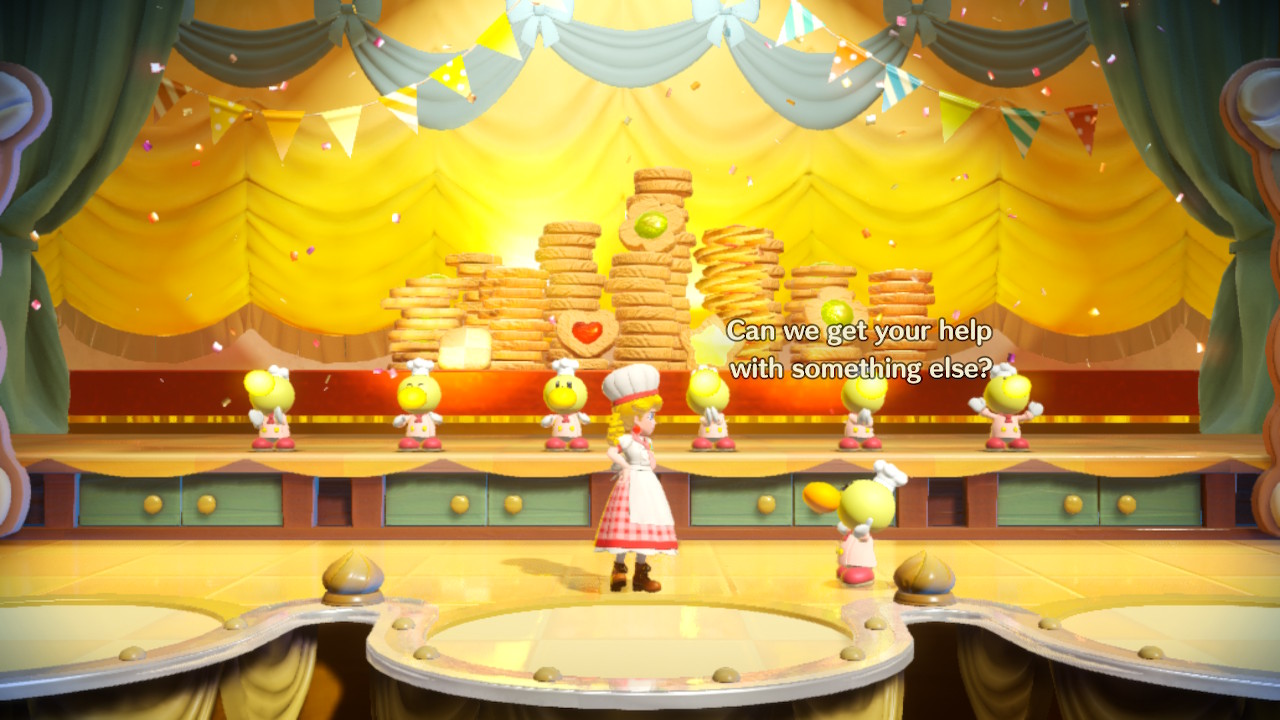
Not only are the appearances of each of Peach’s transformations very cutely designed, but they feature distinct animations that further help set them apart. I especially appreciate Patissiere Peach’s adorable little back-and-forth skip whenever you stand still.
This shortcoming aside, each floor concludes with a boss fight, all of which are definite highlights. The boss designs are memorable and each encounter involves some strong mechanics. One sees you defeating a genuinely quite creepy projector-themed cat as it tries to swat you away with attacks that are represented by 2D projected images, while another has a giant disco-ball bird that can flip the entire stage into its mirror image in order to crush you with falling blocks. There are also separate challenge levels, called rehearsals, that offer reimagined versions of past stages with difficult special conditions. These are some of the hardest challenges in the game and make for a delightful diversion.
The same is true of the unlockable outfits for both Peach and Stella, which can be purchased from a small stall in the foyer using hidden stars collected from each level, obtained by rescuing a top-hat-wearing character hidden in each level, or are awarded for finishing certain stages. There are loads to discover, giving you plenty of reasons to comb over past environments for anything that you might have missed.
It’s a fantastic way to round out an overall package that’s already got plenty to offer. Whether you’re a long-time Super Mario fan or a complete newcomer to the series, Princess Peach: Showtime! is an excellent adventure that’s easy to recommend.
Accessibility
Princess Peach: Showtime! has some limited accessibility features, including the option to reduce the intensity of controller vibration or reverse the button layout. As there is no voiced dialogue, information is conveyed through text throughout though its size or overall appearance cannot be adjusted. An optional item that decreases the difficulty is also readily available from the beginning of the game.
Should I play Princess Peach: Showtime!?
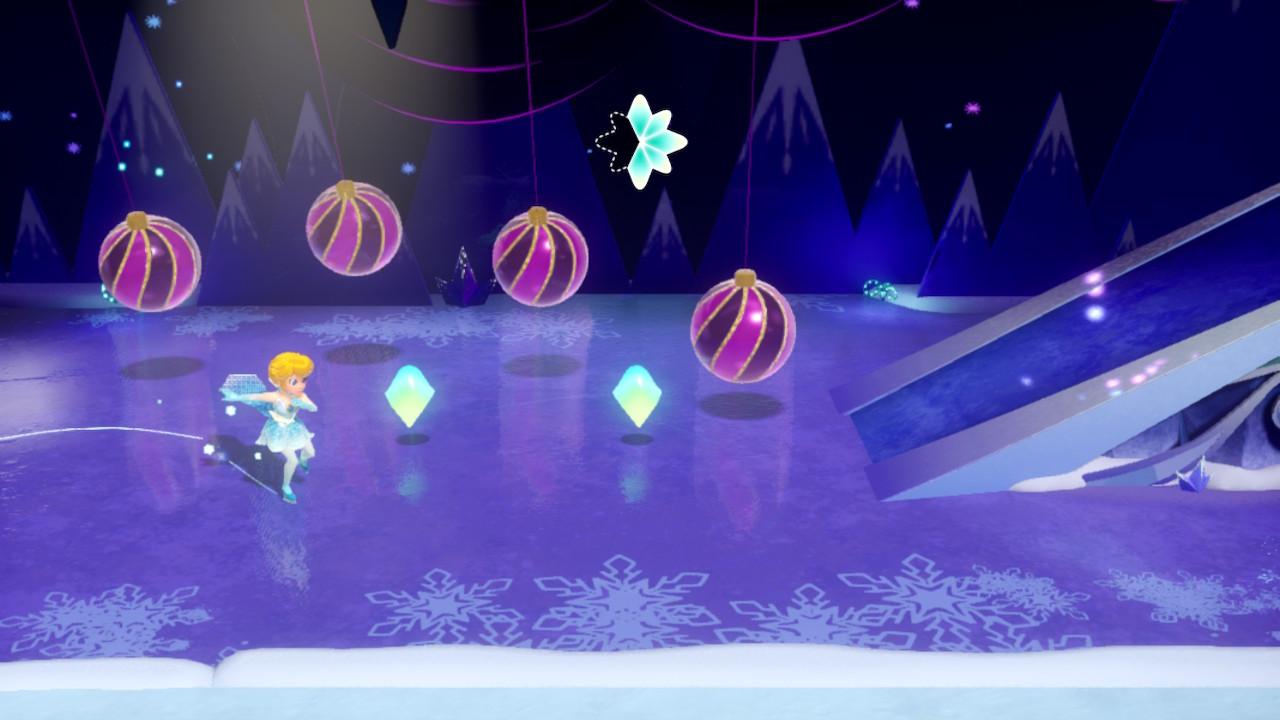
Play it if…
Don’t play it if…
How we tested Princess Peach: Showtime!
I played Princess Peach: Showtime! on a Nintendo Switch OLED console for over ten hours using a copy of the game provided by Nintendo. During that time I reached the end credits and completed almost all of the available side content. Although I played predominantly in handheld mode using a pair of Joy-Con controllers, I was also careful to test the game’s performance in docked mode where I played with a Nintendo Switch Pro Controller.


















